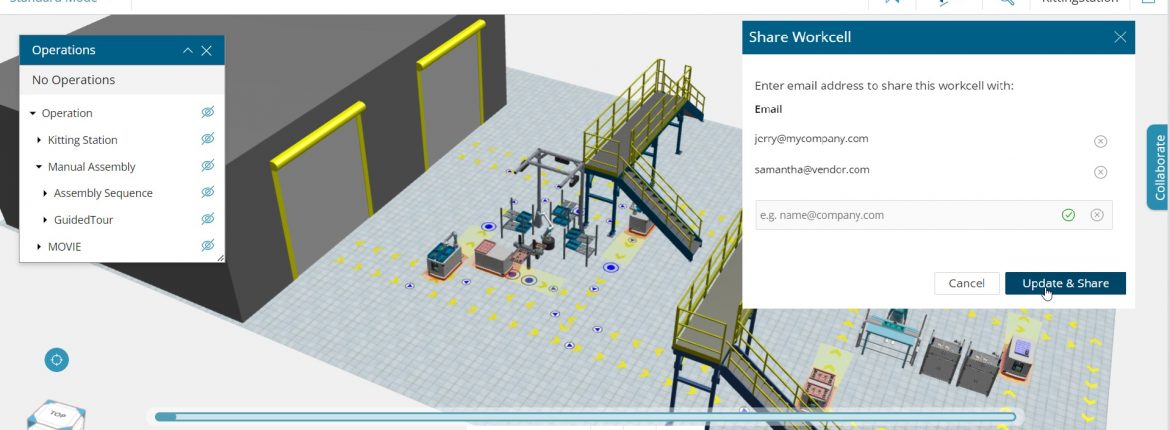
Optimize your production line with Process Simulate Collaborate, a cloud-based solution. Streamline design, simulate workflows, and collaborate effortlessly.
In the field of robotics simulation, numerous challenges can arise when it comes to planning, simulating, and validating human tasks, robotics processes, and automation throughout the product development journey. Design change requests, alterations in robot paths, and collision detection can disrupt the workflow. Communicating these changes to all stakeholders involved, include engineering, plant management, quality control, shop floor, and even pre-sales and marketing teams and vendors, can be cumbersome.
Picture this scenario: not all stakeholders have access to Process Simulate software, therefore they rely on various devices such as iPads, projectors, or mobile devices to review and provide feedback to a static study. The sharing of simulation studies typically involves converting them into static images, presentations, PDFs, and screen recordings.
Managing different versions of the study further complicates matters, resulting in an inefficient, non-collaborative, and manual sharing process. To address these challenges, we introduce Process Simulate Collaborate — a cloud-based collaborative solution that enables seamless visualization, review, and analysis of factory production lines and work cells authored in Process Simulate, anytime, anywhere, and with anyone.
Collaborating and exchanging robotic simulation studies becomes important and helps drive design improvements, evaluate performance, optimize parameters, analyze robotic workcell errors, and helps to reduce costs.
Maximizing Collaboration Efficiency: Leveraging Process Simulate Collaborate with Process Simulate
Process Simulate Collaborate stands out with its exceptional features that simplifies uploading, sharing, and collaboration processes. Let’s take a closer look at how this cloud-based software transforms the way we collaborate in the cloud and boosts productivity.
Upload, share and collaborate
The cloud-collaboration journey begins with the transfer of the Process Simulate study on a user’s local desktop and opening Process Simulate Collaborate on the cloud. With just a single click within Process Simulate, the line designer or simulation engineer uploads the study, enabling internal and external stakeholders to access and share it. This step unlocks the potential for internal and external stakeholders to access and share the study, promoting collaboration and knowledge exchange.
By adding the email addresses of the stakeholders, the line designer or simulation engineer can easily share the workcell with them for review. To facilitate discussions and brainstorming sessions, a collaboration link can be included, leading to an interactive meeting with a video conferencing platform. This digital environment allows stakeholders to discuss the study in real-time, discussing the digital twin version of the Process Simulate study, leading to improved productivity and faster decision-making.
Seamless Feedback integration
A key aspect of collaboration is granting control and visibility to the reviewers of the Process Simulate study, such as an OEM. Process Simulate Collaborate enables reviewers to showcase design changes in real time, ensuring that everyone is on the same page. When a design change request emerges, the line simulation engineer takes the initiative to include a note, taking into consideration its priority level (low, medium, or high) and the specific type of note (general, safety, collision, or ergonomic). These well-documented notes serve to communicate the details and significance of the design change. They provide essential context and clarity to the process simulate engineer, ensuring they are promptly informed about the requested modification through the review feedback.
By integrating a structured approach of adding notes and receiving feedback, the robotics simulation workflow becomes more organized and efficient. This systematic collaboration enables seamless communication between team members and facilitates a smooth progression of the simulation process, ultimately leading to optimized results.

Don’t hesitate to contact Thanh for advice on automation solutions for CAD / CAM / CAE / PLM / ERP / IT systems exclusively for SMEs.
Luu Phan Thanh (Tyler) Solutions Consultant at PLM Ecosystem Mobile +84 976 099 099
Web www.plmes.io Email tyler.luu@plmes.io
